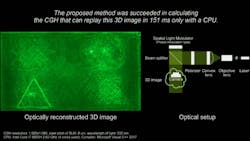New algorithm speeds up calculations for head-up-display holograms by 56 times
Researchers from Tokyo Metropolitan University have developed a new way of calculating simple holograms for head-up displays (HUDs) and near-eye displays (NEDs). The method is up to 56 times faster than conventional algorithms and does not require power-hungry graphics processing units (GPUs), instead running on normal computing cores like those found in PCs. This opens the way to developing compact, power-efficient, next-generation augmented-reality (AR) devices, including 3D navigation on car windshields and eyewear.
The deployment of truly 3D displays that don't need special glasses is yet to become widespread. Recent advances have seen virtual reality (VR) technologies make their way into the market, but the vast majority rely on optical tricks that convince the human eye to see things in 3D. This is not always feasible and limits its scope.
Why haven't holograms been used more often in 3D displays? One reason is that generating the hologram of arbitrary 3D objects is a computationally heavy exercise. This makes every calculation slow and power-hungry, a serious limitation when you want to display large 3D images that change in real-time. The vast majority require specialized hardware like graphics processing units (GPUs), severely limiting where holographic 3D displays can be deployed.
No FFT needed
A team led by Assistant Professor Takashi Nishitsuji at Tokyo Metropolitan University looked at how holograms were calculated. They realized that not all applications needed a full rendering of 3D polygons. By solely focusing on drawing the edge around 3D objects, they succeeded in significantly reducing the computational load of hologram calculations. In particular, they could avoid using fast-Fourier transforms (FFTs), the intensive math routines powering holograms for full polygons.
The team combined simulation data with real experiments by displaying their holograms on a spatial light modulator (SLM) and illuminating it with laser light to produce a real 3D image. At high resolution, they found that their method could calculate holograms up to 56 times faster, and that the images compared favorably to those made using slower, conventional methods. Importantly, the team only used a normal PC computing core with no standalone graphics processing unit, making the whole process significantly less resource hungry.
Faster calculations on simpler cores means lighter, more compact, power-efficient devices that can be used in a wider range of settings. The team have their sights set on heads-up displays (HUDs) on car windshields for navigation, and even AR eyewear to relay instructions on hands-on technical procedures -- both exciting prospects for the not too distant future.
To see the video, go to https://www.eurekalert.org/multimedia/pub/233502.php
Source: https://www.eurekalert.org/pub_releases/2020-06/tmu-lfa060220.php
Got optics- and photonics-related news to share with us? Contact John Wallace, Senior Editor, Laser Focus World
Get more like this delivered right to your inbox

John Wallace | Senior Technical Editor (1998-2022)
John Wallace was with Laser Focus World for nearly 25 years, retiring in late June 2022. He obtained a bachelor's degree in mechanical engineering and physics at Rutgers University and a master's in optical engineering at the University of Rochester. Before becoming an editor, John worked as an engineer at RCA, Exxon, Eastman Kodak, and GCA Corporation.
